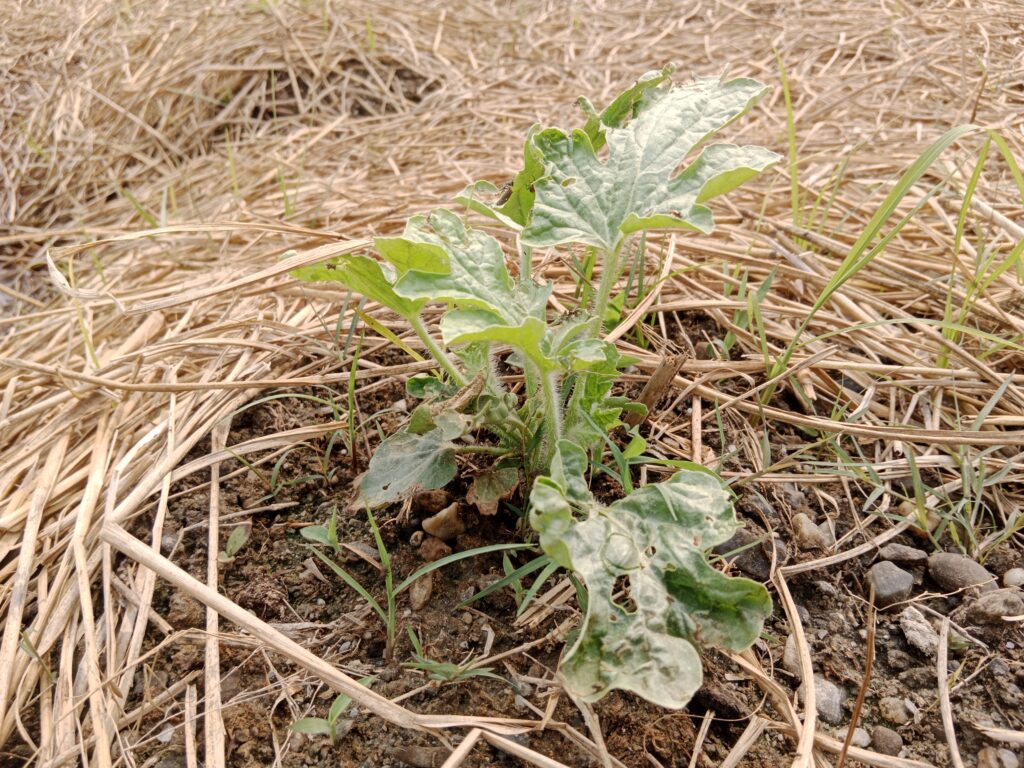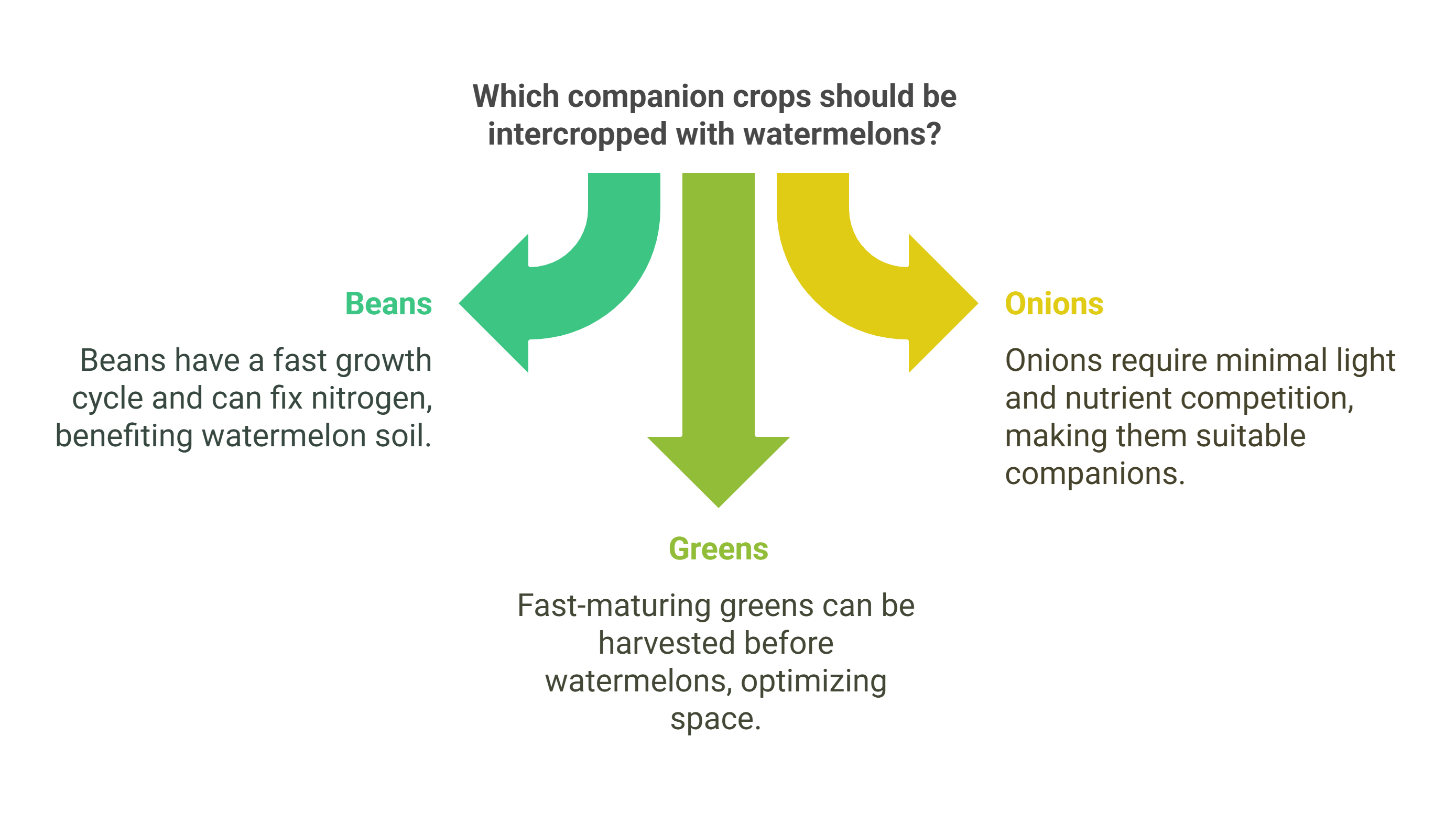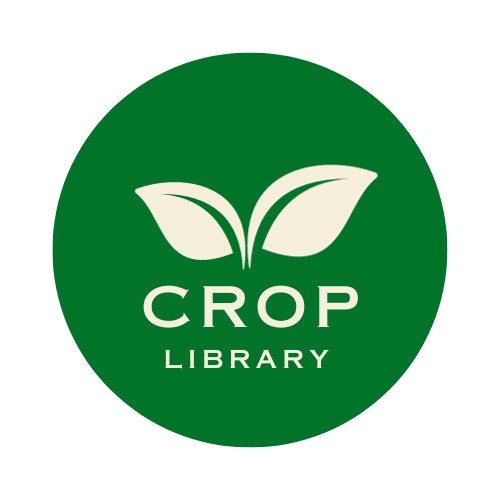Watermelon Cultivation
Watermelon cultivation involves growing the popular fruit crop Citrullus lanatus, known for its juicy, sweet flesh, which is ideal for fresh consumption and agro-processing like juice making. As a warm-season crop, watermelon cultivation requires careful management to ensure high yields and quality, with vines spreading 6 to 8 feet in 30 days and producing the first fruits within 60 days, ready for harvest in about 3 months.

Watermelons are rich in nutrients, containing approximately 6% sugar and 92% water by weight, along with essential components like Potassium, Vitamin A, Vitamin C, Folate, Amino acids, and powerful antioxidants such as Lycopene. Successful watermelon cultivation depends on warm temperatures, full sun, and ample fertilization, as the plants are heavy feeders. This refreshing and delicious fruit thrives in many parts of the world, making it a rewarding crop for farmers and gardeners alike.
Land Preparation for Watermelon Cultivation
The first step in watermelon cultivation is clearing the field of weeds, rocks, and debris. Deep plowing (20–30 cm) follows to improve soil aeration and loosen the soil. The field is then leveled using a harrow to create a fine tilth, ensuring optimal seedbed conditions.
To enhance drainage and prevent waterlogging, elevated beds or ridges are prepared, spaced 1.5–2 meters apart. The land undergoes two crosswise plowings to refine the soil texture, making it suitable for sowing and promoting healthy watermelon growth.
Soil Type
Watermelon thrives in sandy loam or loamy soils because they are rich in organic matter, provide proper drainage, and retain adequate moisture. The ideal soil pH for nutrient uptake ranges from 6.0 to 7.0, which is neutral to slightly acidic. Clay-heavy soil is less suitable as they hold excess water, leading to poor aeration and increased risk of root rot. For optimal growth, it’s crucial to choose well-draining soils or enhance them with organic amendments to improve structure and fertility.
Climatic Requirements for Watermelon Cultivation
| Climatic Factor | Requirement for Watermelon Cultivation |
| Temperature | Warm (25°C – 35°C); sensitive to frost and cold, unsuitable for cool climates. |
| Rainfall | Moderate (600–1000 mm); excessive rain can cause waterlogging and increase disease risks. |
| Sunlight | Full sunlight is essential for healthy vine growth and high-quality fruit development. |
Major Cultivars of Watermelon
| Cultivar | Shape & Size | Flesh Characteristics | Rind Appearance | Maturity Period | Key Features & Uses |
| Sugar Baby | Small, spherical (8–10 lbs / 3.5–4.5 kg) | Deep red, very sweet, juicy | Dark green, thin | 75–80 days | Early maturity; ideal for short growing seasons, home gardens, and farmers’ markets. |
| Crimson Sweet | Oval (20–25 lbs / 9–11 kg) | Bright red, crisp, high sugar | Light green with dark stripes | 85–90 days | Disease-resistant; great for commercial farming, fresh markets, and processing. |
| Charleston Gray | Large, oblong (30–40 lbs / 14–18 kg) | Red, firm, sweet, slightly coarse | Light green, thick | 90–100 days | Crack-resistant; excellent for transport, storage, and commercial production. |
| Jubilee | Long, striped (25–30 lbs / 11–14 kg) | Bright red, juicy, excellent flavor | Light green with dark stripes | ~90 days | High-yielding; suited for fresh markets, processing, and home/commercial farming. |
| Black Diamond | Very large, round (50+ lbs / 23+ kg) | Deep red, sweet, rich flavor | Thick, dark green | 90–95 days | Extremely durable; ideal for large-scale farming, storage, and long-distance transport. |
Planting
| Planting Aspect | Details |
| a) Planting Season | · Tropical regions: Year-round · Temperate regions: Spring or early summer (after frost risk) |
| b) Spacing | · Between rows: 2 meters · Between plants: 90 cm |
| c) Pit Preparation | · Size: 30 cm × 30 cm × 30 cm · Mix: Well-decomposed manure/compost with soil before filling |
| d) Planting Method | Seed treatment · Soak in lukewarm water for 12 hours · Drain and keep in wet gunny bag overnight Sowing · Direct sowing or transplanting seedlings · 2-3 seeds per pit at 2-3 cm depth · Seed rate: ~800g/acre Thinning · Keep 1 healthy seedling per pit after germination
|
| e) Plants per Acre | · Average: ~2,200 plants · Varies based on: |
Intercropping in Watermelon Cultivation
To optimize land utilization and enhance farm output, watermelon can be grown alongside fast-maturing companion crops like beans, onions, or greens. When implementing this practice, farmers should choose intercrops that have minimal competition with watermelons for essential growth factors including soil nutrients, moisture, and light. Proper selection ensures harmonious coexistence, allowing both the primary watermelon crops and secondary intercrops to develop fully without compromising each other’s productivity or quality.

Irrigation Management in Watermelon Cultivation
a). Pre-Planting Stage
To make sure the soil is damp but not soggy, the area should be lightly irrigated prior to planting. Early root development and seed germination are facilitated by properly prepared soil.
b). Planting to Germination Stage
It is advised to lightly water the soil every two to three days after sowing in order to maintain constant moisture levels. To guarantee effective germination and avoid seed rot, excessive watering should be avoided.
c). Seedling Stage
Once seedlings emerge, moderate irrigation every 4–5 days supports healthy root growth. The soil should remain moist but well-drained to avoid waterlogging, which can stunt young plants.
d). Vine Development Stage
As vines spread, water demand increases. Irrigation every 5–7 days ensures vigorous growth. Drip or furrow irrigation is ideal to maintain moisture without excessive wetting.
e). Flowering Stage
Consistent and deep irrigation every 5–7 days is crucial during flowering. Water stress at this stage can cause flower drop, reducing fruit set and yield.
f). Fruit Setting Stage
Maintaining uniform soil moisture (every 5–7 days) prevents misshapen or undersized fruits. Avoid dry spells followed by heavy watering, as this can lead to fruit cracking.
g). Fruit Maturation Stage
As fruits near maturity, gradually reduce irrigation to every 7–10 days. Overwatering during ripening can dilute sweetness and increase cracking risk.
h). Pre-Harvest Stage
Stop irrigation 7–10 days before harvest to enhance sugar concentration and improve shelf life. This step ensures sweeter, firmer fruits with better market quality.
Fertilizer and Manure Management for Watermelon Cultivation
Below is the detailed fertilizer schedule per acre for watermelon cultivation.

a). Pre-Planting (Soil Preparation)
For optimal soil preparation before planting watermelons, apply 10 tons of farmyard manure (FYM) or compost per acre to enrich the soil with organic matter, then thoroughly mix in 800 grams each of Azospirillum and Phosphobacteria along with 1 kilogram of Pseudomonas biofertilizers, combined with 20 kg of FYM and 40 kg of neem cake to promote soil health and provide balanced nutrients for initial plant growth.
b). Planting (Seeding/Transplanting Stage)
During the planting stage (seeding/transplanting), apply a starter fertilizer containing 10kg of Nitrogen (N) and 20-25kg of Phosphorus (P₂O₅) derived from DAP or equivalent fertilizers directly into the planting rows or holes to promote vigorous root development and ensure proper establishment of watermelon plants.
c). Vegetative Growth Stage (2-4 Weeks)
During the vegetative growth stage (2-4 weeks after planting), apply 10-15kg of Nitrogen (N) through urea and 10-15kg of Potassium (K₂O) using potassium sulfate per acre to stimulate robust vine expansion and healthy foliage development, which are crucial for establishing a strong foundation for subsequent flowering and fruiting.
d). Flowering Stage (4-6 Weeks)
At the flowering stage (4-6 weeks after planting), apply 10-15kg of Nitrogen (N) using urea along with 15-20kg of Potassium (K₂O) through Muriate of Potash or potassium sulfate per acre to enhance flower formation, improve pollination, and support optimal fruit setting, which are essential for achieving high yields and quality watermelon production.
e). Fruit Development Stage (6-8 Weeks)
During the critical fruit development stage (6-8 weeks after planting), apply a balanced fertilizer mixture containing 5-10kg of Nitrogen (N), 10-15kg of Phosphorus (P₂O₅) from DAP, and 20-25kg of Potassium (K₂O) through potassium sulfate or Muriate of Potash per acre to promote optimal fruit expansion, enhance natural sugar accumulation, and improve overall fruit quality, ensuring well-developed, sweet, and marketable watermelons. This targeted nutrient application supports proper cell division, carbohydrate translocation, and fruit maturation processes essential for premium yield outcomes.
f). Ripening Stage (8-12 Weeks)
During the ripening stage (8-12 weeks after planting), it’s crucial to minimize nitrogen application while focusing on potassium supplementation by applying 10-15kg of K₂O per acre through potassium-based fertilizers like potassium sulfate, as this strategic nutrient management enhances sugar accumulation, improves flesh firmness, and ensures optimal fruit quality at harvest, while preventing excessive vegetative growth that could compromise fruit sweetness and post-harvest shelf life.
Weed Control
| Aspect of Weed Control | Methods & Recommendations | Benefits |
| Importance | Critical in early growth stages to prevent yield reduction due to weed competition. | Protects young, vulnerable plants from nutrient and resource competition. |
| Mulching | Use plastic or organic materials (straw, dried leaves). | Suppresses weeds, conserves moisture, regulates soil temperature, improves soil health. |
| Manual Weeding | Remove weeds by hand or tools, ensuring minimal disturbance to watermelon plants. | Effective for small-scale cultivation; avoids chemical use. |
| Herbicide Use | Apply selectively and carefully; choose herbicides safe for watermelons. Follow label instructions. | Controls weed efficiently in large-scale farming. |
| Integrated Approach | Combine mulching, manual weeding, and selective herbicide use. | Ensures weed-free environment, promotes healthy growth, and maximizes yield. |
Pest and Disease Management in Watermelon Cultivation
Common Pests
| Pest | Scientific Name | Damage Symptoms | Management Strategies |
| Red Pumpkin Beetle | Aulacophora foveicollis | Skeletonizes leaves, creates holes in foliage/flowers, and stunts growth. | Crop rotation, manual removal, neem-based insecticides, or chemical pesticides if severe. |
| Fruit Fly | Bactrocera spp. | Larvae feed on fruit pulp, causing rot and unmarketable fruits. | Fruit fly traps, bait sprays, field hygiene (destroy infested fruits). |
| Sting Bug | Corythaica spp. | Sap-sucking causes wilting, yellowing; honeydew leads to sooty mold. | Neem oil/insecticidal soap, field sanitation, regular monitoring. |
| Aphids | Aphis gossypii | Curling/yellowing leaves, stunted growth; vectors viruses (e.g., cucumber mosaic). | Release ladybugs, neem oil/soaps; chemical insecticides if severe. |
| Hairy Caterpillar | Spilosoma spp. | Defoliation, reduced photosynthesis, yield loss. | Manual removal, Bacillus thuringiensis (Bt), chemical insecticides if needed. |
Common Diseases
| Disease | Causal Agent | Symptoms | Management Strategies | |
| Powdery Mildew | Podosphaera xanthii | White powdery patches on leaves/stems; reduced photosynthesis, premature defoliation | Resistant varieties, proper spacing, sulfur/potassium bicarbonate fungicides, regular monitoring | |
| Downy Mildew | Pseudoperonospora cubensis | Yellow angular leaf spots with purplish-gray fungal growth underneath; leaf withering | Fungicides (mancozeb/chlorothalonil), improve air circulation, avoid overhead irrigation | |
| Anthracnose | Colletotrichum orbiculare | Brown leaf spots, sunken dark fruit lesions; rapid spread in warm/humid conditions | Crop rotation, remove infected debris, fungicides (azoxystrobin/copper sprays), resistant varieties | |
| Blight | Alternaria/Phytophthora | Dark water-soaked lesions on leaves/stems/fruits; rapid tissue decay in wet conditions | Fungicides (metalaxyl/chlorothalonil), improve drainage, destroy infected plant material | |
| Fusarium Wilt | Fusarium oxysporum | Yellowing, wilting due to blocked vascular system; persists in soil for years | Soil fumigation/solarization, resistant cultivars, crop rotation with non-hosts, maintain soil health | |
Harvesting
Watermelons typically mature in 70–90 days, depending on the variety. To check for peak ripeness, watch for three key signs: a hollow sound when tapped, a dried brown tendril near the stem, and a creamy yellow patch on the underside where the melon touched the ground. These indicators ensure optimal sweetness and texture at harvest time.
When harvesting, use a sharp knife to cut the fruit, leaving 2–3 cm of stem attached to maintain freshness. Handle watermelons with care to prevent bruising, as damage reduces shelf life and market quality. Proper post-harvest practices and gentle transportation are essential to deliver premium fruit to consumers.


